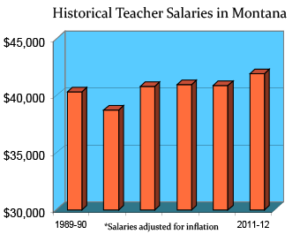Montana Teaching Salaries and Benefits

Montana is in need of more teachers. A report from the state Board of Education notes that Montana faces a shortage of education professionals, requiring approximately 900 new teachers each year to keep up with rising school enrollment and those leaving their careers.
Hoping to attract and retain more teachers in the state, Montana offers a host of benefits to better support its educators. All teachers in Montana enter into the state’s retirement system, ensuring they receive lifetime pension payments in their post-teaching lives. Additionally, most school systems offer comprehensive health insurance benefits to teachers, helping them remain financially secure as they teach in the state.
Learn more about becoming a teacher. Contact schools offering teacher education/certification programs in Montana.
Teacher Salaries in Montana by Education
As teachers further their educations and gain experience in the field, they receive pay increases that reflect their dedication and hard work. Salaries may vary between school districts, but the following are some examples of the salaries you can expect in Montana:
| Experience | Bachelor’s | Master’s |
|---|---|---|
| At 3 years | $32,687 | $36,248 |
| At 6 years | $36,065 | $40,539 |
| At 9 years | $39,444 | $44,831 |
| At 12 years | $42,822 | $49,122 |
Source: Great Falls Public Schools
Retiring in Montana
Once you gain employment at a Montana school, you automatically enter into the state Teachers’ Retirement System (TRS). The TRS currently serves over 12,000 retirees and beneficiaries, distributing nearly $180 million per year in retirement, disability, or survivor benefits.
The Montana TRS is a defined benefit program, meaning you and your employer contribute a set percentage of salary to the fund each year. Currently, teachers in Montana contribute 7.15% of their gross salaries, while schools provide an additional 7.47%.
Your contributions are invested into a general pension fund, where they accrue interest over time. Once you reach retirement age and meet service qualifications, you’re eligible to begin receiving payments from the fund in monthly increments.
Teachers in Montana are eligible for retirement under the following circumstances:
- At age 60 with five years of service
- At any age with 25 years of service
- At age 50 with five years of service (early retirement)
If you meet these qualifications and terminate employment, you then begin earning monthly pension benefits for the remainder of your life. Your exact benefits are determined by a formula set by the Montana legislature that takes into account your years of service and salary.
You can estimate your likely benefits with the following formula:
Years of Service
multiplied by
Average Final Compensation
multiplied by
1.6667%
For example, if you worked for 30 years and retired with an average salary of $36,000, you’re eligible to earn $1,500 in monthly payments.
You have several payment options regarding your pension benefits. Some teachers choose to receive their full payments, while others reserve a portion of benefits to a fund that becomes available to a beneficiary upon death. If you’re interested in learning more details regarding your pension and payment options, contact the Montana Teachers’ Retirement System.
Access to Affordable Health Insurance
Whether or not you receive health insurance benefits as a Montana teacher rests on the school district you work for. While many schools offer these benefits to teachers, smaller, more rural districts may not.
Your costs and level of coverage will depend on your employing school. While some schools will cover your entire health insurance premium, others will require you to contribute additional funds.
Health insurance plans offered to teachers typically cover most medical services. Some of these services include:
- Preventative Care
- Home Health Care
- Physical Therapy
- Chiropractic Care
- Hospital Visits
- Ambulance Services
Many schools offer teachers not only health benefits, but vision, dental, and life insurance as well. If you wish to know more about your specific benefits, contact your local school district.




